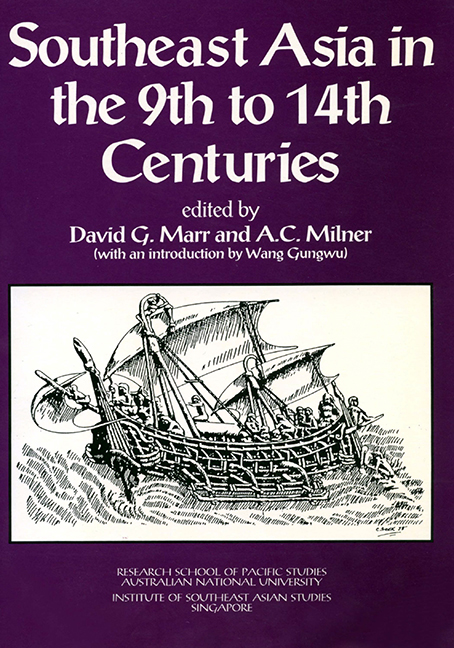Book contents
- Frontmatter
- Contents
- Contributors
- Preface
- Introduction
- 1 The Early and the Imperial Kingdom in Southeast Asian History
- 2 Hydraulic Works and South East Asian Polities
- 3 Some Notes on Relations between Central and Local Government in Ancient Java
- 4 Negara, Mandala, and Despotic State: Images of Early Java
- 5 Some Remarks on Early State Formation in Cambodia
- 6 “Elephants Can Actually Swim”: Contemporary Chinese Views of Late Ly Dai Viet
- 7 Authority and Legitimacy in 11th Century Vietnam
- 8 From Myth to History: Imagined Polities in 14th Century Vietnam
- 9 Shipshape Societies: Boat Symbolism and Political Systems in Insular Southeast Asia
- 10 Changing Perspectives in Island Southeast Asia
- 11 Political and Cultural Continuities at Dvaravati Sites
- 12 The True and the Corbel Arch in Mainland Southeast Asian Monumental Architecture
- 13 Vietnamese Ceramics and Cultural Identity: Evidence from the Ly and Tran Dynasties
- 14 Traditions, Acculturation, Renovation: The Evolutional Pattern of Vietnamese Culture
- 15 Symbolism of Kingship in Arakan
- 16 Buddhism in Champa
- 17 The Ordering of Generations: Change and Continuity in Old Javanese Kinship
- 18 Sources on Economic Activities in Khmer and Cham Lands
- 19 Narrative Bas-Reliefs at Candi Surawana
- 20 Possibilities for a Reading of the 1293-1357 Period in the Vietnamese Annals
- Index
- Miscellaneous Endmatter
2 - Hydraulic Works and South East Asian Polities
Published online by Cambridge University Press: 21 October 2015
- Frontmatter
- Contents
- Contributors
- Preface
- Introduction
- 1 The Early and the Imperial Kingdom in Southeast Asian History
- 2 Hydraulic Works and South East Asian Polities
- 3 Some Notes on Relations between Central and Local Government in Ancient Java
- 4 Negara, Mandala, and Despotic State: Images of Early Java
- 5 Some Remarks on Early State Formation in Cambodia
- 6 “Elephants Can Actually Swim”: Contemporary Chinese Views of Late Ly Dai Viet
- 7 Authority and Legitimacy in 11th Century Vietnam
- 8 From Myth to History: Imagined Polities in 14th Century Vietnam
- 9 Shipshape Societies: Boat Symbolism and Political Systems in Insular Southeast Asia
- 10 Changing Perspectives in Island Southeast Asia
- 11 Political and Cultural Continuities at Dvaravati Sites
- 12 The True and the Corbel Arch in Mainland Southeast Asian Monumental Architecture
- 13 Vietnamese Ceramics and Cultural Identity: Evidence from the Ly and Tran Dynasties
- 14 Traditions, Acculturation, Renovation: The Evolutional Pattern of Vietnamese Culture
- 15 Symbolism of Kingship in Arakan
- 16 Buddhism in Champa
- 17 The Ordering of Generations: Change and Continuity in Old Javanese Kinship
- 18 Sources on Economic Activities in Khmer and Cham Lands
- 19 Narrative Bas-Reliefs at Candi Surawana
- 20 Possibilities for a Reading of the 1293-1357 Period in the Vietnamese Annals
- Index
- Miscellaneous Endmatter
Summary
Introduction
Whatever the merits of “The great river valley” theory for delineating the ancient pattern of settlement in the Near East, North India and North China, it seems to have little relevance in ancient South East Asia. Although the mainland of South East Asia was in large part created by three of the world's great rivers: the Irrawaddy, the Chao Phraya and the Mekong, none of the earliest cities and states was located in their vicinity. This extraordinary fact has been noted with surprise in regard to the Mekong, in a recent study of ancient Khmer civilization.[1] In fact, it is equally true of the ancient pattern of settlement of the Pyūs in Central Burma, the Mōns in Central and Southern Thailand and the ancient inhabitants (probably Mōn) of the Trans-Bassac Plain in Southern Vietnam. The fact that early civilizations developed on the fringes of the great alluvial tracts of the Irrawaddy, Mekong and Chao Phraya rather than in their richest soils, is at first sight the more enigmatic in view of the needs of agriculture and the range of opportunities that were apparently neglected through this pattern of settlement.
Pyū sites are typically located in side valleys of the Irrawaddy, on the more limited alluvia created by perennial but highly seasonal rivers such as the Yin and Nawin. The ancient Khmers occupied a similar habitat along a series of rivers draining into Tonlé Sap or into the Mekong River from the North and the West. The Mon sites of Central Thailand and the head of the Malay Peninsula are on the periphery of the Chao Phraya alluvium or close to much smaller rivers such as the Mae Khlong and the Khwae Noi. The ancient sites of the Trans-Bassac Plain are in fact - despite the title of the site survey - well away from the delta of the Mekong,[2] along the fringes of its alluvia or on those laid down by smaller rivers. Similar ecological conditions surround the sites belonging to the Satingpra complex in South Thailand. Excavated sites with this significant pattern of distribution can be traced from the 2nd century BC down to the 14th century AD and range from small sites like Pong Tuk to vast ones like Śrī Ksetra and Angkor.
- Type
- Chapter
- Information
- Southeast Asia in the 9th to 14th Centuries , pp. 23 - 48Publisher: ISEAS–Yusof Ishak InstitutePrint publication year: 1986

